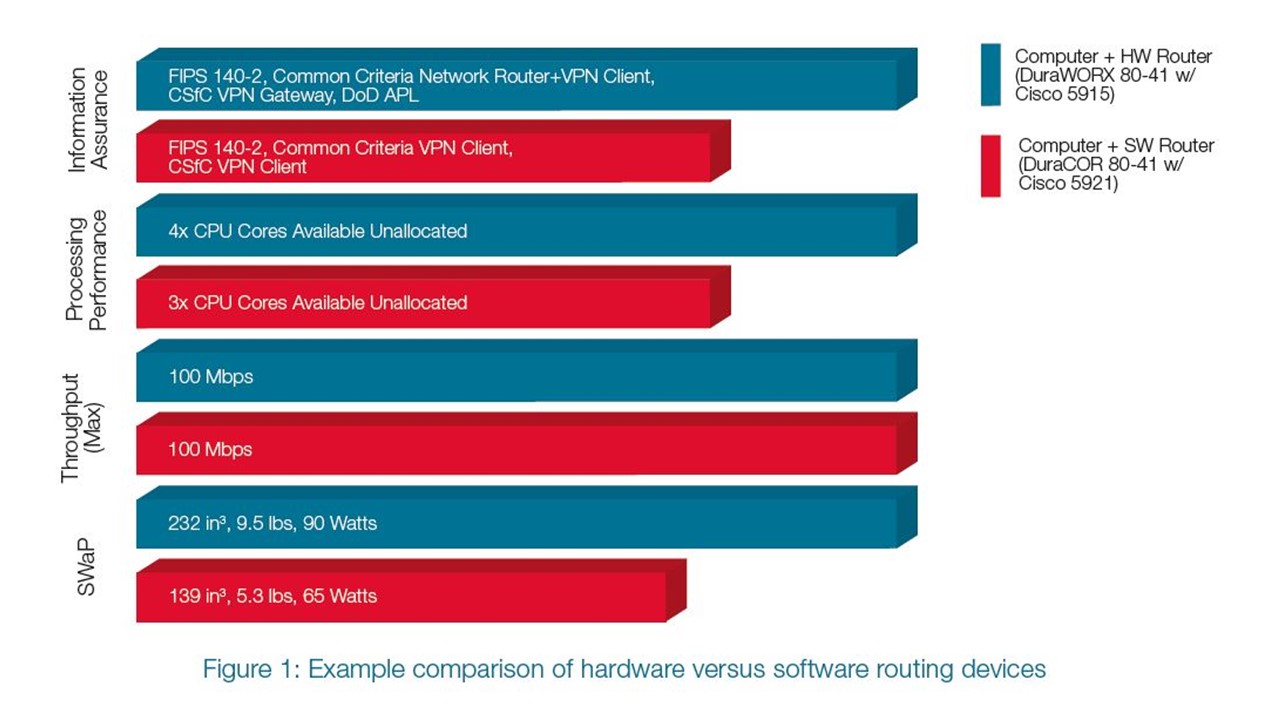
Cisco Systems, the worldwide leader in networking technology, not only offers Embedded Services Router (ESR) card-level products (i.e. Cisco 5915 ESR) but now also software-based router options (Cisco 5921 ESR). This is enabling users to choose between hardware (HW) and software (SW) based architectural approaches and yet take advantage of the same familiar Cisco IOS command line interface and feature sets. Both of these HW and SW-based routing technologies have been integrated into rugged size, weight and power (SWaP)-optimized systems for use in aerospace and defense applications, and each has relative advantages and trade-offs.
Curtiss-Wright has developed a range of products based on these hardware or software ESRs, which depending on the product, may also integrate mission processors and/or Ethernet switches. When making the hardware versus software router decision, one should take into consideration the network topology, as well as SWaP considerations, processing power requirements, back haul throughput, and information assurance. Below is a brief overview of some of these considerations:
- SWaP:
- Though standalone hardware routers are the smallest and lightest weight option, they are dedicated for routing meaning a separate mission processor is required for general-purpose processing.
- Though additional Ethernet switch ports can be added to a router system additional space is required for such additions.
- Hardware routers have a finite number of ports where software routers support scalability.
- Standalone routers require less power consumption to operate then PC based devices. Where multi-function devices are concerned, a software-based router + computer combo generates less power that a hardware-based router + computer combo.
- Multi-function software-based router/computer solutions have a size and weight advantage over hardware-based route/computer solutions since no specialized hardware is integrated for routing. But this comes at the tradeoff of one logical CPU’s resources.
- Processing Performance:
- In standalone HW routers, all routing functions are performed by dedicated ASICs, so the measure of CPU utilization is irrelevant. CPU utilization is not impacted by routing functions, as computer and router are distinct hardware devices.
- In software-based router systems, however, a portion of its CPU resources is assigned to routing functionality, specifically between ¼ to ½ of the CPU core’s resources, depending on the Internet Mix.
- Advanced security or specialized network services add additional processes for the software router to manage, therefore increasing CPU utilization.
- Maximum Throughput:
- Throughput testing indicates little difference in speeds up through Fast Ethernet bandwidth of 100Mbps max. for both types of routers.
- Software router throughput rate won’t change whether there is only one routed port open or ten, whereas there are only two ports possible on the hardware router.
- Information Assurance:
- The hardware based router protects data in transit by using an on-board hardware encryption processor; the software based router also supports encryption but doesn't have the added benefit of hardware acceleration.
- Enabling encryption on either type of router reduces network traffic throughput and impacts CPU utilization.
- Hardware routers have more comprehensive information assurance certifications due to their maturity and approved lab testing methodologies.
